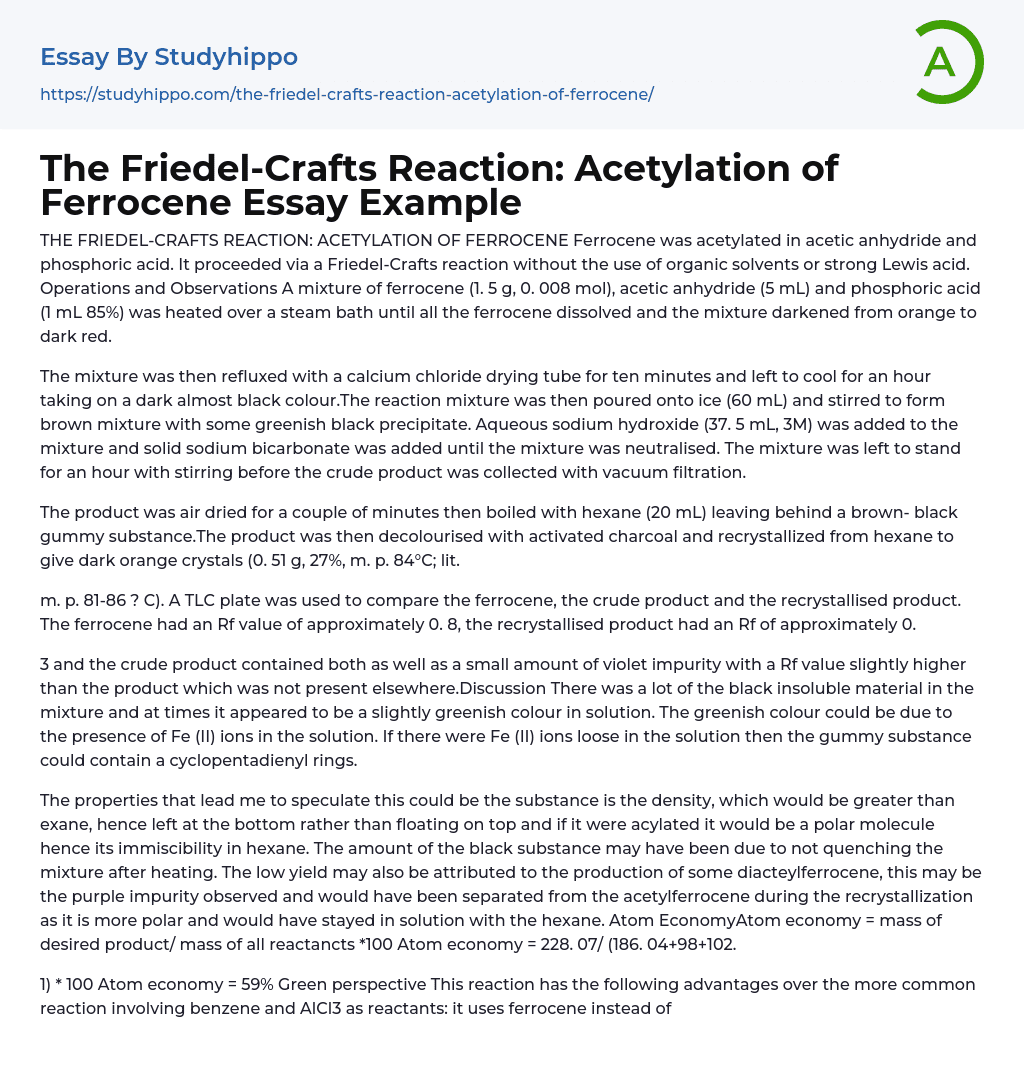

The Friedel-Crafts Reaction: Acetylation of Ferrocene Essay Example
Ferrocene was acetylated in acetic anhydride and phosphoric acid. It proceeded via a Friedel-Crafts reaction without the use of organic solvents or strong Lewis acid. Operations and Observations A mixture of ferrocene (1. 5 g, 0. 008 mol), acetic anhydride (5 mL) and phosphoric acid (1 mL 85%) was heated over a steam bath until all the ferrocene dissolved and the mixture darkened from orange to dark red.
The mixture was then refluxed with a calcium chloride drying tube for ten minutes and left to cool for an hour taking on a dark almost black colour.The reaction mixture was then poured onto ice (60 mL) and stirred to form brown mixture with some greenish black precipitate. Aqueous sodium hydroxide (37. 5 mL, 3M) was added to the mixture and solid sodium bicarbonate was added until the mixture was neutrali
...sed. The mixture was left to stand for an hour with stirring before the crude product was collected with vacuum filtration.
The product was air dried for a couple of minutes then boiled with hexane (20 mL) leaving behind a brown- black gummy substance.The product was then decolourised with activated charcoal and recrystallized from hexane to give dark orange crystals (0. 51 g, 27%, m. p. 84°C; lit. m. p. 81-86 ? C). A TLC plate was used to compare the ferrocene, the crude product and the recrystallised product.
The ferrocene had an Rf value of approximately 0. 8, the recrystallised product had an Rf of approximately 0. 3 and the crude product contained both as well as a small amount of violet impurity with a Rf value slightly higher than the product which was not present elsewhere.Discussion There was
a lot of the black insoluble material in the mixture and at times it appeared to be a slightly greenish colour in solution. The greenish colour could be due to the presence of Fe (II) ions in the solution. If there were Fe (II) ions loose in the solution then the gummy substance could contain a cyclopentadienyl rings.
The properties that lead me to speculate this could be the substance is the density, which would be greater than exane, hence left at the bottom rather than floating on top and if it were acylated it would be a polar molecule hence its immiscibility in hexane. The amount of the black substance may have been due to not quenching the mixture after heating. The low yield may also be attributed to the production of some diacteylferrocene, this may be the purple impurity observed and would have been separated from the acetylferrocene during the recrystallization as it is more polar and would have stayed in solution with the hexane. Atom EconomyAtom economy = mass of desired product/ mass of all reactancts *100 Atom economy = 228. 07/ (186. 04+98+102.1)
100 Atom economy = 59% Green perspective This reaction has the following advantages over the more common reaction involving benzene and AlCl3 as reactants: it uses ferrocene instead of benzene which is a carcinogenic, it doesn’t use a solvent, it uses acetic anhydride which goes to a benign acetic acid waste, it doesn’t use AlCl3 which is corrosive and gives off HCl when it comes into contact with moisture.One of the advantages of this reaction is that it doesn’t use benzene, which is carcinogenic, and it doesn’t use AlCl3 which
is corrosive. The reaction also uses one of the reagents, acetic anhydride, as the solvent negating the need for organic solvents such as dichloromethane or carbon disulphide. Acetic anhydride also forms benign acetic acid as a waste when mixed with water.
The choice of ferrocene as the reagent enables the use of phosphoric acid instead of AlCl3 as it is highly reactive.One of the disadvantages of this reaction is that ferrocene is listed as harmful and highly flammable. Phosphoric acid is listed as corrosive. Acetic anhydride is listed as causing respiratory tract irritation and severe eye irritation, is flammable, corrosive and can have and very reactive with water. The purification involves a recrystallization with hexane, nullifying its claim that no organic solvents were used.
The reaction also is only useable with highly reactive reagents so it can’t be applied to all Friedel-Crafts reactions. A more green reaction involves the use of Nafion strips to act as the acid catalyst and microwave heating. ‘Nafion® is a perfluorinated ion-exchange membrane which has a wide variety of commercial uses. The acidic (hydrogen ion) form and derivatives are solid, superacid catalysts useful in a wide variety of synthetic applications. ’ It is recyclable, relatively non-hazardous and easy to remove from the products.
Microwave heating reduces energy requirements and appeared to reduce the amount of side-products formed. Yields for this procedure (40-60%) exceeded the yield obtained using procedure.
- Acid Rain essays
- Accounting essays
- Marketing essays
- Automation essays
- Business Cycle essays
- Business Model essays
- Business Operations essays
- Business Software essays
- Corporate Social Responsibility essays
- Infrastructure essays
- Logistics essays
- Manufacturing essays
- Multinational Corporation essays
- Richard Branson essays
- Small Business essays
- Cooperative essays
- Family Business essays
- Human Resource Management essays
- Sales essays
- Market essays
- Online Shopping essays
- Selling essays
- Strategy essays
- Management essays
- Franchising essays
- Quality Assurance essays
- Business Intelligence essays
- Corporation essays
- Stock essays
- Shopping Mall essays
- Harvard Business School essays
- Harvard university essays
- Trade Union essays
- Cooperation essays
- News Media essays
- Waste essays
- Andrew Carnegie essays
- Inventory essays
- Customer Relationship Management essays
- Structure essays
- Starting a Business essays
- Accounts Receivable essays
- Auditor's Report essays
- Balance Sheet essays
- Costs essays
- Financial Audit essays
- International Financial Reporting Standards essays
- Tax essays
- Accountability essays
- Cash essays



